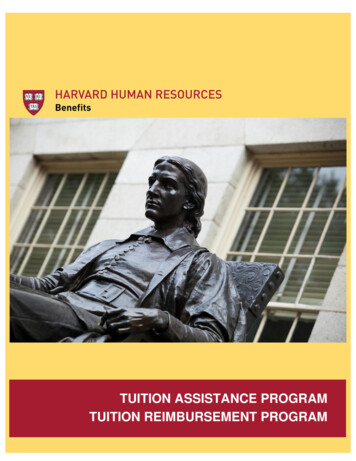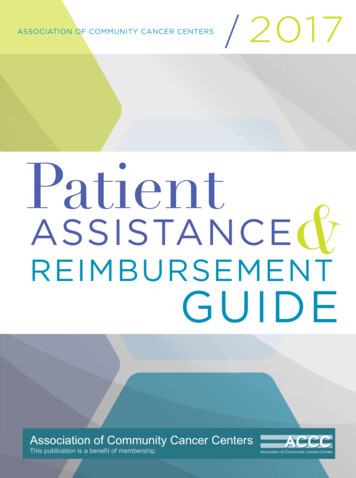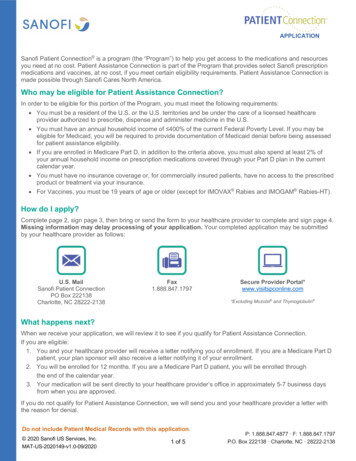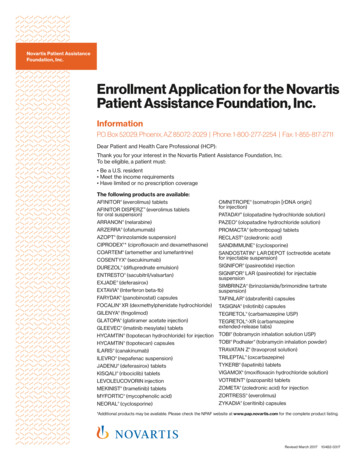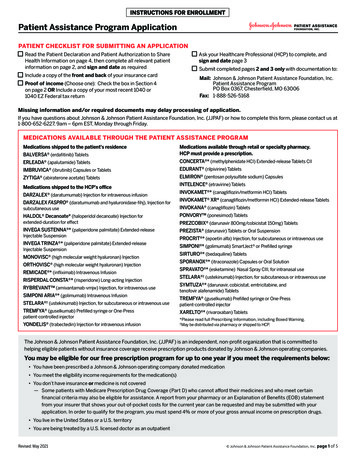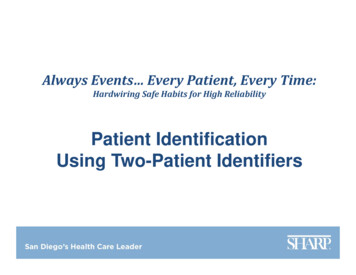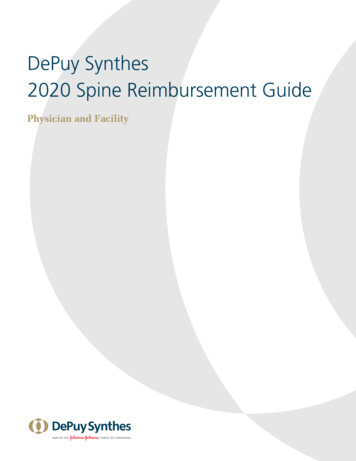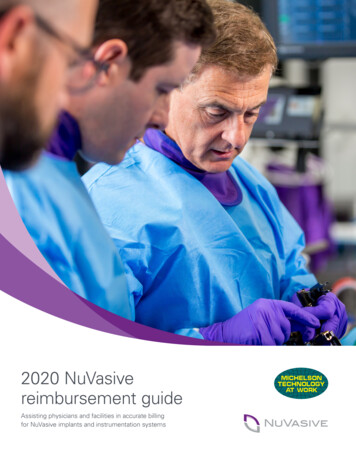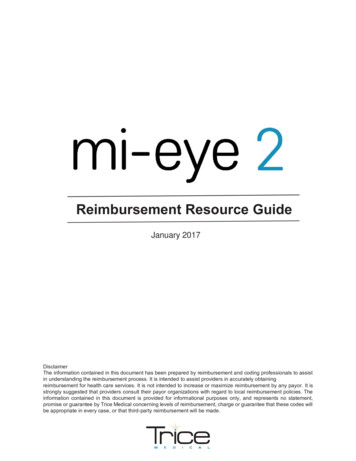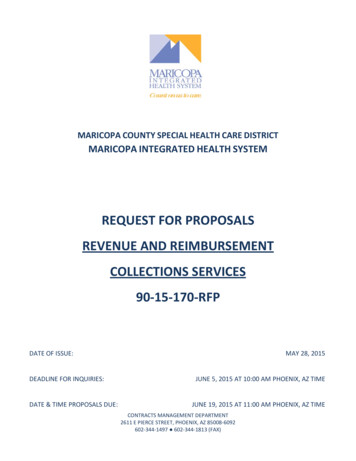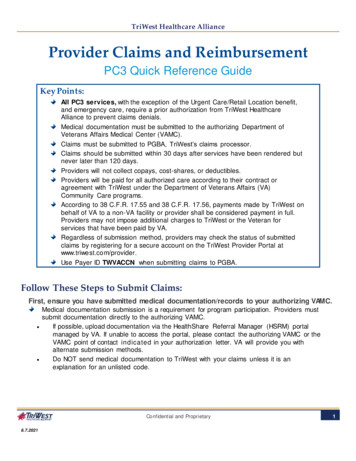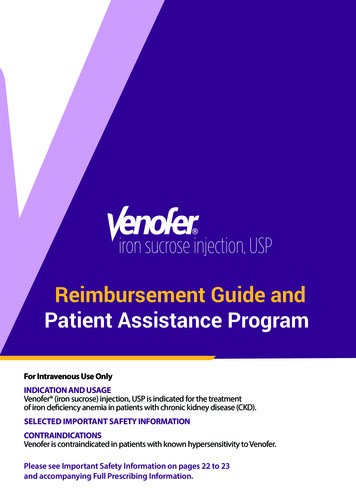
Transcription
Reimbursement Guide andPatient Assistance ProgramFor Intravenous Use OnlyINDICATION AND USAGEVenofer (iron sucrose) injection, USP is indicated for the treatmentof iron deficiency anemia in patients with chronic kidney disease (CKD).SELECTED IMPORTANT SAFETY INFORMATIONCONTRAINDICATIONSVenofer is contraindicated in patients with known hypersensitivity to Venofer.Please see Important Safety Information on pages 22 to 23and accompanying Full Prescribing Information.1
Table of ContentsI. IntroductionFor ReimbursementI.Introduction. . . . . . . . . . . . . . . . . . . . . . . . . . . . . . 3II.Coverage. . . . . . . . . . . . . . . . . . . . . . . . . . . . . . . . 4III.Coding. . . . . . . . . . . . . . . . . . . . . . . . . . . . . . . . . . 7IV.Venofer Payment in All Settings. . . . . . . . . . . . 11V.VenAccess Reimbursement Hotline. . . . . . . . . 18VI.VenAccess Patient Assistance Program. . . . . 19Important Safety Information . . . . . . . . . . . . . . . 22Full Prescribing Information . . . . . . . . . . . . . . . . InsertReimbursement Quick Guide. . . . . . . . . . . . . . . . InsertUnderstanding today’s complex world of healthcare reimbursement requiresa good sense of direction. Even though Venofer (iron sucrose) injection, USPhas been in the marketplace since the year 2000 as a trusted iron product, thereimbursement landscape changes daily. Constant shifts in Medicare rules,payer policies, billing edits (eg, Medically Unlikely Edits), and medical codingare reasons to refer to this guide, whether you have billed for Venofer once or ahundred times.Caring for patients with chronic kidney disease (CKD) requires that providerswork closely with third-party payers to ensure that they are paid fully and fairlyfor medically necessary healthcare items and services. American Regent, themanufacturer of Venofer, wants prescribing providers to better understand thecomplexities of reimbursement. The company has prepared this guide to assistyou with common questions about Venofer and its reimbursement.This guide provides general coverage, coding, and updated payment informationabout Venofer to help you better understand the policies of the Medicareprogram and other third-party payers. The guide should also help you avoidtroublesome denials based on real-world data. The goal is to help you get paidfully and fairly for every claim.If you need more help, American Regent’s VenAccess Reimbursement Hotlineis available to provide assistance and to answer all of your payment questions.This hotline can be reached by calling 877-4-IV-IRON (877-448-4766), Mondaythrough Friday, between 9 am and 8 pm ET.Please refer to the Venofer full Prescribing Information enclosed in the pocketof this guide and the Important Safety Information on pages 22 to 23.Please see Important Safety Information on pages 22 to 23 andaccompanying Full Prescribing Information.3
For those of you who are newer to billing, coverage refers to 2 things. First,coverage is contingent upon whether the patient’s policy covers a particularaspect of care. For example, if a patient has major medical coverage withoutprescription coverage, self-administered (prescription) drugs probably will notbe covered under that benefit. But non-self-administered (“buy-and-bill”) drugs,like Venofer (iron sucrose) injection, USP, will be covered in a doctor’s office orhospital outpatient setting under the major medical benefit as long as certainparameters are met, as described in the next paragraph.The second aspect of coverage is whether a particular payer, per their ownpolicies, will cover a particular item or service. Generally, a drug is coveredif it is FDA-approved, given for the diagnoses that the FDA approved it for,and administered per the package insert, which is an outline of what theFDA approved for that drug. Added to that, the drug must be necessary andappropriate for a specific patient, which means that the patient must havethe correct diagnosis and be eligible, in terms of health status, to receive theproduct. Both public and private payers may modify or widen this coverage byissuing policies that specify how and when they will cover a product like Venofer.Medicare CoverageMedicare is likely to cover Venofer and its administration when used for itsFDA- approved indication and when administered per its package insert. Venoferis approved for the treatment of iron deficiency anemia (IDA) in adult patientswith CKD. Under Medicare Part B (the doctor’s office), it must be given incidentto a provider’s service. In order to meet all the general requirements for coverageunder the incident-to provision, an FDA-approved drug or biologic must be: a) ofa form that is not usually self-administered; b) furnished by a physician practice;and c) administered by the physician or by auxiliary personnel employed by thephysician and under the physician’s personal supervision.1CoverageII. CoverageThe charge, if any, for the drug or biologic must be included in thephysician’s bill, and the cost of the drug or biologic must represent an expenseto the physician. Drugs and biologics furnished by other health professionals(nurse practitioners, physician assistants, and clinical nurse specialists withMedicare billing capability) may also meet these requirements. (See sections170, 180, 190, and 200 in Chapter 15 of the Medicare Benefit Policy Manual forspecific instructions.)1In addition, Venofer (iron sucrose) injection, USP is approved for maintenancetherapy in pediatric (greater than 2 years of age) hemodialysis patients with irondeficiency anemia, whether or not they are on erythropoietin-stimulating agent(ESA) therapy. Venofer is also approved for maintenance therapy in pediatric(greater than 2 years of age) non-dialysis and peritoneal-dialysis patients withiron deficiency anemia who are on ESA therapy. Patients on dialysis are coveredby a separate benefit under Medicare Part A. Additionally, the Medicare rulesfor dialysis facilities include bundled payments. The bundled per-treatmentpayment includes drugs, laboratory services, supplies, and capital-related costsrelated to furnishing maintenance dialysis. So, Venofer may be covered but notpaid for separately in dialysis facilities.2Additionally, for dialysis patients, there is a National Coverage Determinationby Medicare, which takes precedence over local intermediary decisions. TheNational Coverage Determination states, “Effective October 1, 2001, Medicarealso covers iron sucrose injection as a first line treatment of iron deficiencyanemia when furnished intravenously to patients undergoing chronichemodialysis who are receiving supplemental erythropoietin therapy.”3For non-dialysis patients, Medicare Part B coverage may be determined bylocal carriers or Medicare Administrative Contractors (MACs), who areresponsible for issuing local coverage determinations (LCDs) that detail coverageguidelines.4 Additionally, carriers and MACs are responsible for processingMedicare claims. Prior authorization (PA) is not required under Part B. Also,Medicare coverage policies must be drafted and approved by a group ofclinicians in your area called the Carrier Advisory Council (CAC). This body givesthe public a voice in Medicare policy. Please see the CMS.gov website (linkbelow) for more information.** ails/ncd-details.aspx?NCDId 156&ncdver 1&bc AAAAQAAAAAAA&.Please see Important Safety Information on pages 22 to 23 andaccompanying Full Prescribing Information.5
Commercial Payers and Medicare AdvantageFrequent benefit investigation (sometimes known as insurance verification) isnecessary for commercial patients—particularly if they are Affordable Care Act(ACA) patients with premiums or are on employer-based insurance. If patientsdo not pay premiums or they change jobs, this can impact insurance coverage.Healthcare insurance policies also have various levels of coverage and may have“caps” for drugs. This needs to be ascertained for each policy.Additionally, commercial payers often publish policies regarding iron productslike Venofer. You should check the payer policies for Venofer each time youinfuse a patient and each time you initiate a new course of iron treatment withVenofer. You can also verify how a policy applies to your patient at the time ofprior authorization.MedicaidMedicaid may also cover Venofer when it is used for its FDA-approvedindications. Medicaid patient eligibility guidelines and coverage policies varyfrom state to state, and some states maintain mandatory review criteria forincluding a product as an approved drug or service. Medicaid programs maybase their coverage guidelines on Medicare or commercial payers or have morerestrictive coverage. Most Medicaid programs in 2020 require prior authorizationfor branded drugs like Venofer.III. CodingProper coding of services is key to your success in terms of billing for Venofer (iron sucrose) injection, USP given in your office or clinic. Why is coding socrucial? Codes are simply an abbreviated way of describing the appropriatenessand medical necessity of treatments given in your facility. This is what codesdescribe, in a nutshell:CodingMedicare Part C is called Medicare Advantage (MA) and currently coversapproximately 36.5% of Medicare patients. MA plans are private plans thatmust cover the same breadth of services that traditional Medicare does. But,other than that, MA behaves like a commercial payer and not like Medicare interms of coverage and payment. Almost all private payers these days, includingMA, require prior authorization for branded drugs like Venofer (iron sucrose)injection, USP. This will tell you definitively whether a commercial plan will coverVenofer for your patient. ICD-10-CM/diagnosis codesshow medical necessity of Venofer in terms of the reason for giving it CPT (HCPCS Level I) codesdemonstrate how Venofer was given to the patient HCPCS Level II codesprovide evidence of the type of drug and how much of it was givenor wastedMore details are documented below.A. International Classification of Disease, 10th Edition, ClinicalModification (ICD-10-CM) Diagnosis Coding for VenoferICD-10-CM diagnosis codes identify the patient’s diagnosis and inform insurersof why a service was provided. It should be simple, but it can get difficult withVenofer. First of all, there is a coding guideline that states, “Certain conditionshave both an underlying etiology and multiple body system manifestationsdue to the underlying etiology. For such conditions, the ICD-10-CM has acoding convention that requires the underlying condition be sequenced first, ifapplicable, followed by the manifestation.”5 On the Venofer package insert, theindication is for iron deficiency anemia in chronic kidney disease. So, per codingguidelines, the chronic kidney disease is the underlying condition (etiology), andthe resulting condition (manifestation) is the iron deficiency anemia. Therefore, itis very important that 2 codes are billed—the one for CKD and the one for irondeficiency anemia.Please see Important Safety Information on pages 22 to 23 andaccompanying Full Prescribing Information.7
Examples of diagnosis codes, regardless of the setting, that may support the useof Venofer (iron sucrose) injection, USP in CKD patients include the following:Code NumberDescription From ICD-10-CM 2020N18.1Chronic kidney disease, Stage I ORN18.2Chronic kidney disease, Stage II (mild) ORN18.3Chronic kidney disease, Stage III (moderate) ORN18.14Chronic kidney disease, Stage IV (severe) ORN18.5Chronic kidney disease, Stage V ORN18.6End stage renal disease ORN18.9Chronic kidney disease, unspecified*D63.1Anemia in chronic kidney diseaseVenofer is approved for the treatment of iron deficiency anemia in adultpatients with CKD. In addition, it is also approved for maintenance therapy inpediatric (greater than 2 years of age) hemodialysis patients with IDA, whetheror not they are on ESA therapy. Venofer is also approved for maintenancetherapy in pediatric (greater than 2 years of age) non-dialysis and peritonealdialysis patients with IDA who are on ESA therapy. American Regent makes norepresentation that Venofer is safe and effective in other patients or that it ispermissible or legal to use for other indications.Please check each individual payer for specific ICD-10-CM codes that can beused on claims. Coding is an art, not a science, so payers will vary greatly on whatdiagnoses they will accept. Diagnoses also must be clearly and explicitly noted inthe medical chart.American Regent does not recommend the use of any particular diagnosis codein any particular situation. The above codes are for reference only; coding assubmitted is the sole responsibility of the prescribing physician.B. Healthcare Common Procedure Coding System (HCPCS)Codes, Level I: Current Procedural Terminology (CPT)† CodesCPT codes are used to bill for services provided in both the physician’s officeand other outpatient settings. Venofer (iron sucrose) injection, USP has variousinjection and/or infusion times for the 100 mg, 200 mg, 300 mg, and 400 mgvials. Depending upon the dose and its infusion time, use the appropriatecode(s) from this list:That being said, payers may use other codes for the anemia. Codes that wehave seen in payer policies include the following:D50.0Iron deficiency anemia secondary to blood loss (chronic)D50.1Sideropenic dysphagiaD50.8Other iron deficiency anemiasD50.9Iron deficiency anemia, unspecified** This code should not be used unless absolutely necessary, as many payers, particularly Medicare,will reject unspecified codes for drugs. Please query the treating provider for more specificCKD information.CPT CodeCPT Code Descriptor96374Therapeutic, prophylactic or diagnostic injection (specify substanceor drug); intravenous push, single or initial substance/drug(15 minutes or less)96375Therapeutic, prophylactic or diagnostic injection (specify substanceor drug); intravenous push, separate or sequential substance/drug(15 minutes or less)96365Intravenous infusion, for therapy, prophylaxis or diagnosis (specifysubstance or drug); initial, up to 1 hour (16-90 minutes)96367Intravenous infusion, for therapy, prophylaxis or diagnosis (specifysubstance or drug); initial, separate or sequential substance/drug(16-90 minutes)96366Intravenous infusion, for therapy, prophylaxis or diagnosis(specify substance or drug); each additional hour, up to 8 hours(list separately in addition to code for primary procedure)(over 30 minutes into the next hour)CPT is a registered trademark of the American Medical Association. All rights reserved. 2020.†Please see Important Safety Information on pages 22 to 23 andaccompanying Full Prescribing Information.9
C. H CPCS Codes, Level II: Drug Code for VenoferHCPCS codes are used to identify most drugs and biologics. Venofer (ironsucrose) injection, USP has been assigned the following drug-specific HCPCScode (also known as a J-code):J1756 Injection, Iron Sucrose, 1 mgEach 1 mg of Venofer is equivalent to one (1) service unit. When billing forquantities greater than 1 mg, indicate the total amount used as a multiple ofservice units on the claim form. Service units are very important and must beincluded on every claim. Here are some Venofer examples: One (1) vial (2.5 mL) or 50 mg 50 service units One (1) vial (5 mL) or 100 mg 100 service units One (1) vial (10 mL) or 200 mg 200 service unitsNational Drug Codes are becoming more prevalent in billing for drugs. Manyplans now require NDCs on every claim. The most prominent payers to requireNDCs are UnitedHealthcare and all Medicaid plans.The NDC for Venofer (and all drugs) should be applied to the claim in a 5-4-2format, meaning that there should be 5 digits, then 4 digits, then 2 digits on theclaim, like this:XXXXX-XXXX-XXVenofer is preservative free and available as 50 mg/2.5 mL single-use vials, 100 mg/5 mL single-use vials, and 200 mg/10 mL single-use vials. The NDC numbers are:NDCVial Size00517-2325-102.5 mL Single-Dose Vial (50 mg) (10/pack)00517-2340-105 mL Single-Dose Vial (100 mg) (10/pack)00517-2340-255 mL Single-Dose Vial (100 mg) (25/pack)00517-2340-995 mL Single-Dose Vial (100 mg) (10/pack) Premier ProRx00517-2310-0510 mL Single-Dose Vial (200 mg) (5/pack)A. Reimbursement for Drugs—GeneralDrugs are reimbursed based on pricing by various organizations. Drug pricing isbased on several different types of cost: Average wholesale price (AWP) Wholesale acquisition cost (WAC) Average sales price (ASP) Charged-based payment (Charges)A description of these methods follows below.Average wholesale price: This amount is set by the manufacturer based onwhat wholesalers are paying for the drug. This methodology is rarely used bypayers in the physician office setting but is still sometimes used to pay hospitalsfor drugs.Wholesale acquisition cost: This is set by the manufacturer, is usually about20% less than AWP, and is generally used to pay both physicians and hospitalsbefore an ASP can be established. Non-safety-net (340B) hospitals and physicianoffices are paid WAC plus 3% for drugs by Medicare before the ASP has beenestablished.Average sales price: This price is updated each quarter by manufacturers toMedicare via a spreadsheet. This includes average sales by NDC. Medicare paysall drugs in the physician’s office and pass-through drugs in the hospital at ASPplus 6%. Non-pass-through drugs can be paid at ASP plus 6% in the hospitaloutpatient setting also, but not always. See the Hospital Outpatient section formore details.Charge-based payment: It has been estimated that about a quarter of hospitaldrug payments are based on a formula using hospital charges. Sometimes thisformula is a percentage of what the hospital charges; other times, it is a ratio ofthe hospital’s cost to its charges.Please see Important Safety Information on pages 22 to 23 andaccompanying Full Prescribing Information.11PaymentNational Drug Codes (NDCs)IV. Venofer Payment in All Settings
B. W astage—All DrugsVenofer (iron sucrose) injection, USP is packaged in single-use vials containing50 mg, 100 mg, or 200 mg. If less than the entire vial is administered, theremainder must be discarded. Current CMS policy for outpatient or officeadministered drugs permits billing for the entire vial even if the contents arenot used—but only if the unused portion is discarded and it is appropriatelydocumented. The discarded amount is billed on a second claim line with a “JW”modifier. Note that it is not permissible to bill Medicare twice for the same vial ifthe drug is packaged as a single-dose vial.Commercial and Medicaid payers may accept 2-line billing with Modifier JWattached to the wastage, like Medicare does. UnitedHealthcare, since 2018, hasrequired 2-line billing. However, many non-Medicare payers will allow hospitaland office providers to incorporate the wastage into the total units for the drugso that the wastage and infused drug are combined.C. D rug Payment in the Physician’s Office SettingMedicareCurrently, the payment methodology for all separately payable drugsadministered in physicians’ offices under Medicare is the published ASP, whichincludes a 6% acquisition fee. These rates are updated quarterly by CMS.Medicare will cover 80% of the allowable amount, while the beneficiary or theirsupplemental insurance covers the remaining 20%. Until 2025, there will be2% removed from the 80% Medicare pays for sequestration so that Medicareactually pays ASP plus 4.3% for all office-administered drugs, like Venofer.Private PayersFor private payers, the reimbursement methodologies vary for provideradministered drugs. Reimbursement for Venofer (iron sucrose) injection, USPmay be based on the ASP, which is most likely in the physician’s office, or the AWP.MedicaidFor Medicaid, reimbursement varies by state. It is usually based on AWP or costbut can also be a percentage of charges or based upon a state-specific feeschedule purcha
Medicare Part C is called Medicare Advantage (MA) and currently covers approximately 36.5% of Medicare patients. MA plans are private plans that must cover the same breadth of services that traditional Medicare does. But, other than that, MA behaves like a c
